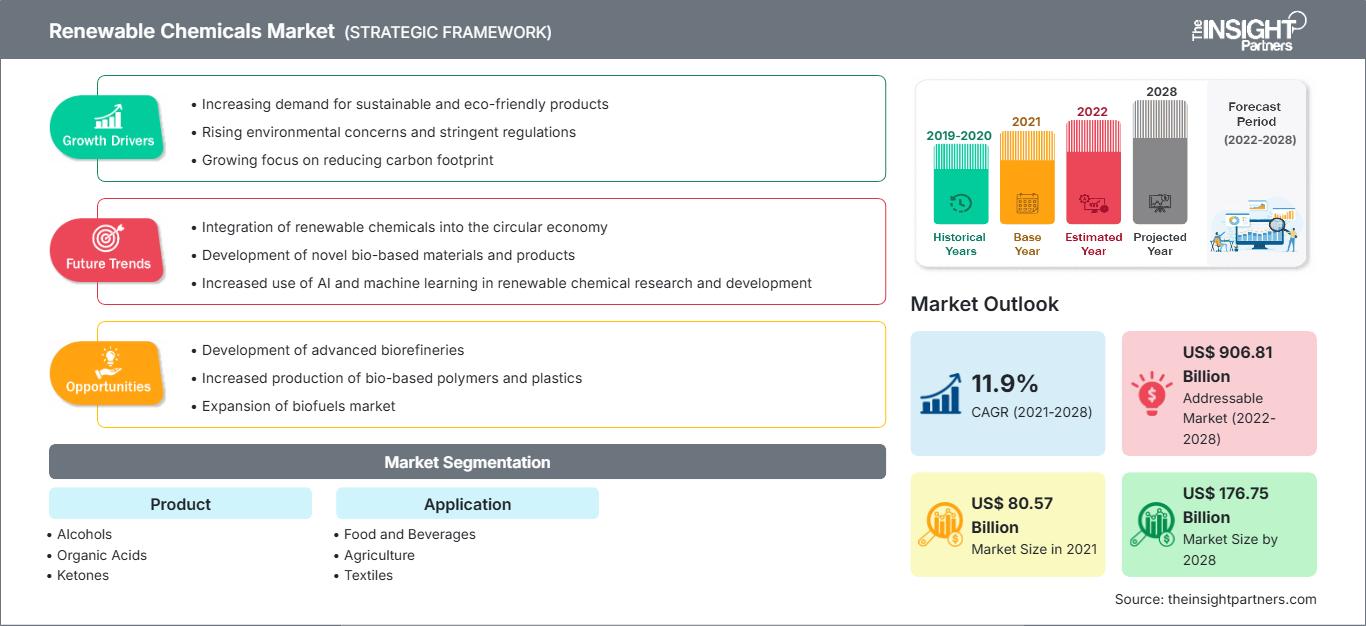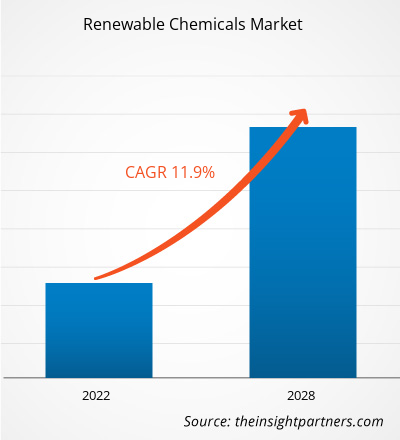재생 가능 화학 물질 시장은 2021년 805억 6,630만 달러 규모로 평가되었으며, 2021년부터 2028년까지 연평균 성장률 11.9%로 성장할 것으로 예상됩니다.
재생 가능 화학 물질 또는 바이오 기반 화학 물질은 농업 원료, 농업 폐기물, 유기 폐기물, 바이오매스, 미생물과 같은 재생 가능 자원에서 합성되는 화학 물질로 정의됩니다. 재생 가능 화학 물질은 기존 석유 기반 화학 물질에 비해 탄소 발자국을 적게 배출하는 지속 가능하고 환경 친화적인 화학 물질로 분류됩니다. 가장 널리 사용되는 재생 가능 화학 물질로는 리그닌, 탄수화물, 오일, 식물 추출물, 헤미셀룰로오스, 셀룰로오스, 전분, 단백질 등이 있습니다. 이러한 화학 물질은 식음료, 농업, 섬유, 자동차, 포장 등 다양한 응용 분야에서 활용되고 있습니다. 2021년 북미 지역은 세계 재생 가능 화학 물질 시장에서 가장 큰 점유율을 기록했습니다. 이 지역의 재생 가능 화학 물질 시장 지배력은 주로 탄탄한 산업 기반과 주요 제조업체들이 시장 성장에 크게 기여하고 있기 때문입니다. 최종 사용 산업 기반의 상당한 성장에 힘입어 식음료, 농업, 섬유, 운송, 포장 등 다양한 산업 분야에서 재생 가능 화학 물질에 대한 수요가 높아지면서 지역 시장의 재생 가능 화학 물질 수요가 증가하고 있습니다. 친환경적이고 지속 가능한 솔루션에 대한 관심 증가와 더불어 제조업 부문에 대한 투자 증가는 북미 재생 가능 화학 물질 시장 성장에 수익성 있는 기회를 제공합니다. 또한, 기존 석유 기반 화학 물질보다 바이오 기반 및 재생 가능 화학 물질의 사용을 장려하는 우호적인 정책은 이 지역에 수익성 있는 성장 기회를 창출할 것으로 예상됩니다.
요구 사항에 맞게 이 보고서를 사용자 정의하십시오.
이 보고서의 일부, 국가 수준 분석, Excel 데이터 팩을 포함하여 모든 보고서에 대한 사용자 정의를 무료로 받을 수 있을 뿐만 아니라 스타트업 및 대학을 위한 훌륭한 제안 및 할인을 이용할 수 있습니다
재생 화학 물질 시장: 전략적 통찰력

- 이 보고서의 주요 주요 시장 동향을 확인하세요.이 무료 샘플에는 시장 동향부터 추정 및 예측에 이르기까지 데이터 분석이 포함됩니다.
이 보고서의 일부, 국가 수준 분석, Excel 데이터 팩을 포함하여 모든 보고서에 대한 사용자 정의를 무료로 받을 수 있을 뿐만 아니라 스타트업 및 대학을 위한 훌륭한 제안 및 할인을 이용할 수 있습니다
재생 화학 물질 시장: 전략적 통찰력

- 이 보고서의 주요 주요 시장 동향을 확인하세요.이 무료 샘플에는 시장 동향부터 추정 및 예측에 이르기까지 데이터 분석이 포함됩니다.
COVID-19 팬데믹이 재생 가능 화학 물질 시장에 미치는 영향
현재 진행 중인 팬데믹은 산업 부문의 상황을 크게 변화시켰고 재생 가능 화학 물질 시장의 성장에 부정적인 영향을 미쳤습니다. 바이러스 확산을 막기 위한 조치 시행은 상황을 악화시켰고 여러 산업 부문의 성장에 영향을 미쳤습니다. 식음료, 농업, 섬유, 운송, 포장, 제약과 같은 산업은 국가 및 국제 경계의 갑작스러운 폐쇄로 인한 운영 효율성의 급격한 왜곡과 가치 사슬의 붕괴로 영향을 받았습니다. 여러 산업 부문의 성장이 크게 둔화되면서 세계 시장의 재생 가능 화학 물질 수요에 부정적인 영향을 미쳤습니다. 공급업체로부터의 원자재 조달 차질과 무기한 봉쇄 및 임시 격리로 인한 제조 시설의 일시적인 폐쇄는 팬데믹 기간 동안 시장 성장에 영향을 미쳤습니다. 그럼에도 불구하고, 각국이 사업 운영을 재개할 계획에 따라 재생 가능 화학 물질에 대한 수요는 전 세계적으로 증가할 것으로 예상됩니다. 적시 생산(just-in-time production)에 대한 집중은 시장 성장을 저해하는 또 다른 우려 요인입니다. 식음료, 농업, 섬유, 운송, 포장, 제약 및 기타 산업 전반에서 재생 가능 화학 물질에 대한 수요 증가와 주요 제조업체들의 상당한 투자는 재생 가능 화학 물질의 성장을 촉진할 것으로 예상됩니다.
시장 분석
환경 문제에 대한 우려 증가로 재생 가능 화학 물질에 대한 인식 제고
재생 가능 과학은 다양한 분야에서 친환경 바이오 기반 화학 물질의 사용을 상용화함으로써 대기, 수질, 토양의 질을 개선하고 지속가능성에 기여하는 효과적인 방법 중 하나로 여겨져 왔습니다. 친환경적이고 지속 가능한 재생 가능 화학 물질은 바이오매스, 농업 잔류물 또는 원료, 그리고 미생물과 같은 재생 가능 원료를 친환경 화학 합성 또는 바이오 정제 과정을 통해 얻을 수 있습니다. 여러 경제권의 정부는 고품질 환경을 촉진하기 위해 탄소 및 온실가스 배출과 관련된 엄격한 규제를 시행해 왔습니다. 예를 들어, 유럽 위원회는 클링커 생산에 사용되는 약 81Mt의 이산화탄소를 단계적으로 폐지하여 2050년까지 탄소 배출량을 80% 감축하는 것을 목표로 합니다. REACH(화학물질 등록, 평가, 허가 및 제한), EPA(환경보호청), 유럽 위원회와 같은 규제 기관은 석유화학 제품의 생산 및 폐기에 대해 엄격한 환경 규정을 시행합니다. 또한 유럽 연합이 '녹색 경제' 구축에 점점 더 집중하고 '20-20-20' 이니셔티브와 결합하면서 석유화학 제품에 대한 수요가 단계적으로 감소하고 있습니다. 주요 산유국의 정치적 불안정과 석유 제품 가격의 변동성과 함께 석유 자원 감소는 재생 가능 화학 제품에 대한 선호도를 높입니다. 지구 온난화와 기후 변화는 건강하고 친환경적이며 깨끗한 제품에 대한 수요를 창출하고 있습니다. 또한, 순환 경제는 재생 가능 화학 물질 관련 기술을 포함한 친환경 기술 개발을 위한 5조 6천억 달러 이상의 새로운 기회를 창출하고 있습니다. 이러한 협력, 규제 및 이니셔티브는 재생 가능 화학 물질 시장의 성장을 촉진합니다.
제품 분석
재생 가능 화학 물질 시장은 제품별로 알코올, 유기산, 케톤, 플랫폼 화학 물질, 바이오폴리머 등으로 분류됩니다. 바이오폴리머 부문은 예측 기간 동안 세계 재생 가능 화학 시장에서 가장 빠르게 성장할 것으로 예상됩니다. 친환경 포장재에 대한 수요 증가와 자동차 산업에서 바이오폴리머 사용 증가는 재생 가능 화학 시장에서 바이오폴리머 성장을 촉진할 것으로 예상됩니다. 바이오폴리머에는 폴리뉴클레오타이드(DNA, RNA), 셀룰로오스, 키토산, 키틴, 전분, 단백질, 폴리에스터, 펙틴, 콜라겐, 젤라틴, 글루텐 등이 포함됩니다. 바이오폴리머는 온실가스 및 유해 물질 배출을 줄이고 재생 불가능한 자원의 사용을 줄이는 혁신적이고 유망한 대안입니다. 친환경적이고 지속 가능한 소재에 대한 관심이 높아짐에 따라 바이오폴리머 수요가 증가할 것으로 예상됩니다.
응용 분야 분석
재생 가능 화학 물질 시장은 응용 분야별로 식음료, 농업, 섬유, 운송, 화학 중간체, 포장, 바이오 의료 및 제약 등으로 분류됩니다. 2021년에는 운송 부문이 재생 가능 화학 물질 시장을 주도할 것으로 예상됩니다. 바이오매스, 목재 칩, 작물 잔류물 등은 재생 가능 운송 연료로 전환됩니다. 바이오부탄올, 바이오에탄올, 바이오메탄올과 같은 다양한 바이오 기반 알코올은 제트기 연료로 사용됩니다. 바이오에탄올은 운송에 가장 널리 사용되는 에너지원입니다. 바이오에탄올 사용량은 향후 몇 년 동안 크게 증가할 것으로 예상되며 앞으로도 높은 수준을 유지할 것입니다. 바이오에탄올 사용 증가 추세는 미래에 더 많은 기회를 제공할 것입니다. 메탄은 운송 연료로 사용되는 또 다른 재생 가능 화학 물질이며 압축 천연 가스의 주요 성분입니다. 메탄은 혐기성 소화라는 생화학적 공정을 통해 바이오매스에서 생산됩니다. 바이오디젤은 천연 오일이나 지방을 알코올(보통 메탄올)과 혼합하여 생산되는 재생 가능한 디젤 연료 대체재입니다. 다양한 식물성 오일, 동물성 지방, 재활용 식용유도 바이오디젤로 전환될 수 있습니다. 재생 가능 화학 시장의 주요 기업으로는 BASF SE, Amyris Inc, DSM, Archer-Daniels-Midland Company(ADM), 그리고 The Dow Chemical Company가 있습니다. 이들 기업은 고품질의 혁신적인 제품 개발에 집중하고 있습니다. 재생 가능 화학 시장
재생 화학 물질 시장
The Insight Partners의 분석가들은 예측 기간 동안 재생 화학 제품 시장에 영향을 미치는 지역별 동향과 요인을 면밀히 분석했습니다. 이 섹션에서는 북미, 유럽, 아시아 태평양, 중동 및 아프리카, 그리고 중남미 지역의 재생 화학 제품 시장 부문 및 지역별 분포도 살펴봅니다.
재생 화학 물질 시장 보고서 범위
| 보고서 속성 | 세부 |
|---|---|
| 시장 규모 2021 | US$ 80.57 Billion |
| 시장규모별 2028 | US$ 176.75 Billion |
| 글로벌 CAGR (2021 - 2028) | 11.9% |
| 이전 데이터 | 2019-2020 |
| 예측 기간 | 2022-2028 |
| 다루는 세그먼트 |
By 제품
|
| 포함된 지역 및 국가 | 북미
|
| 시장 선도 기업 및 주요 회사 프로필 |
|
재생 화학 제품 시장 참여자 밀도: 비즈니스 역학에 미치는 영향 이해
재생 화학 시장은 소비자 선호도 변화, 기술 발전, 그리고 제품의 이점에 대한 인식 제고 등의 요인으로 인한 최종 사용자 수요 증가에 힘입어 빠르게 성장하고 있습니다. 수요가 증가함에 따라 기업들은 제품 라인업을 확장하고, 소비자 니즈를 충족하기 위한 혁신을 추진하며, 새로운 트렌드를 적극 활용하고 있으며, 이는 시장 성장을 더욱 가속화하고 있습니다.

- 을 얻으세요 재생 화학 물질 시장 주요 주요 플레이어 개요
보고서 스포트라이트
- 재생 화학 물질 시장의 진보적인 산업 동향은 참여자들이 효과적인 장기 전략을 개발하는 데 도움이 됩니다.
- 선진국과 개발도상국 시장에서 채택한 사업 성장 전략
- 2019년부터 2028년까지 재생 화학 물질 시장에 대한 정량적 분석
- 재생 화학 물질에 대한 글로벌 수요 추정
- 산업에서 활동하는 구매자와 공급자의 효율성을 보여주기 위한 PEST 분석
- 경쟁적인 시장 시나리오를 이해하기 위한 최근 개발
- 시장 동향 및 전망과 재생 화학 물질 시장 성장을 주도하고 제한하는 요소
- 상업적 관심을 뒷받침하고 시장 성장을 이끄는 시장 전략을 강조하여 의사 결정 프로세스 지원
- 시장의 자세한 개요 및 세분화, 재생 화학 물질 산업 역학
- 성장이 유망한 다양한 지역의 재생 화학 물질 시장 규모 기회
제품별 재생 가능 화학 제품 시장
- 알코올
- 유기산
- 케톤
- 플랫폼 화학 제품
- 생체 고분자
- 기타
응용 분야별 재생 가능 화학 제품 시장
- 식품 및 음료
- 농업
- 섬유
- 운송
- 화학 중간체
- 포장
- 생물 의학 및 제약
- 기타
회사 프로필
- Archer-Daniels-Midland Company(ADM)
- Cargill Inc
- DSM
- BASF SE
- Amyris Inc
- Evonik Industries AG
- Solvay
- The Dow Chemical Company
- Genomatica, Inc
- Braskem
- 과거 분석(2년), 기준 연도, CAGR을 포함한 예측(7년)
- PEST 및 SWOT 분석
- 시장 규모 가치/거래량 - 글로벌, 지역, 국가
- 산업 및 경쟁 환경
- Excel 데이터세트
최근 보고서
관련 보고서
사용 후기
구매 이유
- 정보에 기반한 의사 결정
- 시장 역학 이해
- 경쟁 분석
- 고객 인사이트
- 시장 예측
- 위험 완화
- 전략 기획
- 투자 타당성 분석
- 신흥 시장 파악
- 마케팅 전략 강화
- 운영 효율성 향상
- 규제 동향에 발맞춰 대응




















 무료 샘플 받기 - 재생 화학 물질 시장
무료 샘플 받기 - 재생 화학 물질 시장